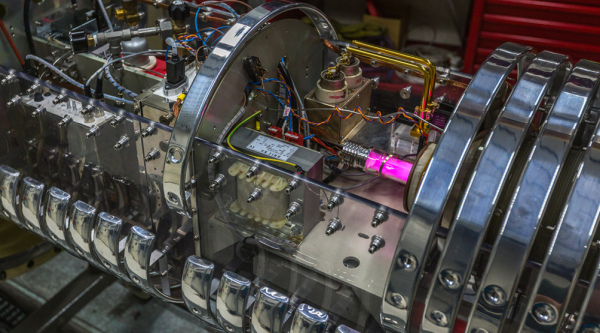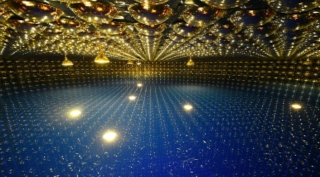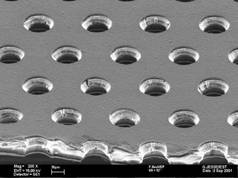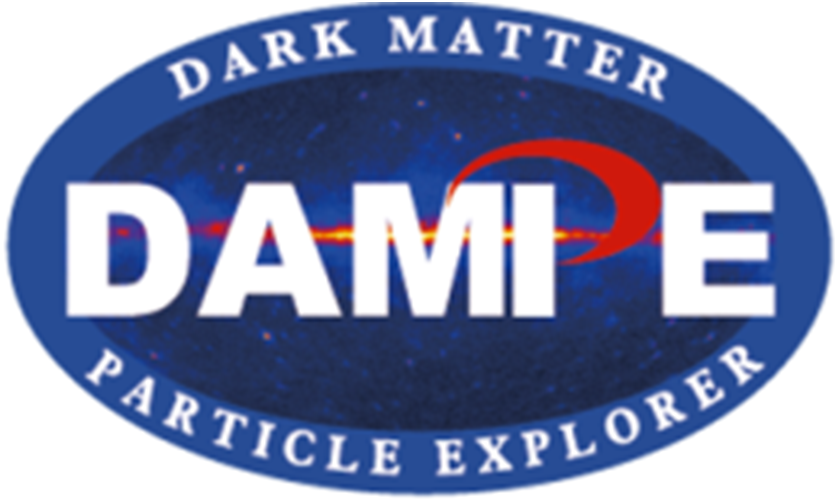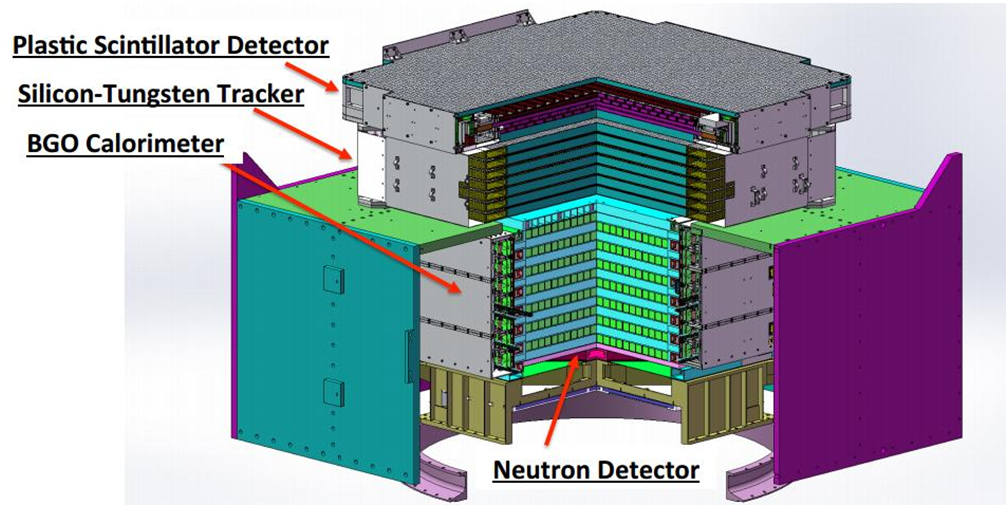Eng
|
Bari activities |
|
Coordinator: Salvatore My |
|
CMS experiment
The Compact Muon Solenoid (CMS) is a general-purpose detector at the CERN Large Hadron Collider (LHC). It has a broad physics programme ranging from studying the Standard Model (including the Higgs boson) to searching for extra dimensions and particles that could make up dark matter. The CMS detector is built around a huge solenoid magnet. This takes the form of a cylindrical coil of superconducting cable that generates a field of 4 tesla, about 100,000 times the magnetic field of the Earth. A steel “yoke” that forms the bulk of the detector’s 14,000-tonne weight confines the field. The CMS experiment is one of the largest international scientific collaborations in history, involving 4300 particle physicists, engineers, technicians, students and support staff from 182 institutes in 42 countries (February 2014).
|
|
TOTEM experiment TOTEM experiment is designed to take precise measurements of protons as they emerge from LHC collisions at small angles. This region is known as the ‘forward’ direction and is inaccessible by other LHC experiments. |
|
RD51 experiment
The proposed R&D collaboration, RD51, aims at facilitating the development of advanced gas-avalanche detector technologies and associated electronic-readout systems, for applications in basic and applied research. The main objective of the R&D programme is to advance technological development and application of Micropattern Gas Detectors. |
|
SHIP experiment
The SHiP Experiment is a new general-purpose fixed target facility at the SPS to search for hidden particles as predicted by a very large number of recently elaborated models of Hidden Sectors, which are capable of accommodating dark matter, neutrino oscillations, and the origin of the full baryon asymmetry in the Universe. Specifically, the experiment is aimed at searching for very weakly interacting long lived particles including Heavy Neutral Leptons – right-handed partners of the active neutrinos; light supersymmetric particles – sgoldstinos, etc; scalar, axion and vector portals to the hidden sector. The high intensity of the SPS and in particular the large production of charm mesons with the 400 GeV beam allow accessing a wide variety of light long-lived exotic particles of such models and of SUSY. Moreover, the facility is ideally suited to study the interactions of tau neutrinos. |
|
LHCb experiment
The LHCb (standing for “Large Hadron Collider beauty”) experiment collecting data at the Large Hadron Collider accelerator at CERN, is a specialized b-physics measurements , that is measuring the parameters of CP violation in the interactions of b-hadrons (heavy particles containing a bottom quark). Such studies can help to explain the Matter-Antimatter asymmetry of the Universe. The detector is also able to perform measurements of production cross sections and electroweak physics in the forward region. Approximately 840 people from 60 scientific institutes, representing 16 countries, form the collaboration who built and operate the detector. |
|
Kloe
 |
|
Bari activities |
| Coordinatore: |
| Attività: Elettronica The CHIPIX65 project has the purpose of exploiting the CMOS 65nm technology on the very front-end electronics for use at future colliders, building core elements in digital and analog electronics and understanding and solve chip integration issues that are particularly important when a sophisticated chip digital circuitry, with an unprecedented amount of transistors, has to be integrated with the very front end analog electronics. Moreover, the radiation hardness of the technology has to be characterized and understood, in particular studying how the performance of electronics are modified, and special circuitry has to be developed to cope with Single Event Upset. We have decided to choose a heavily focused R&D in order to have clear goals and deliverables and an evaluation of the final achievements, implementing the technology on a detector of great interest for the HEP and the INFN, where the requirements on the front end are pushed to the frontier The primary goal of this three years project is to put the basis for the development of an innovative CHIP for a PIXel detector, using a CMOS 65nm technology for the first time in HEP community, for experiments with extreme particle rates and radiation at future High Energy Physics colliders. This effort is shared at international level with the RD53 Collaboration. CHIPIX65 institutes are part of the funding institutions of RD53 and several key roles of the collaboration are covered by CHIPIX65 members. In the three year of the project new circuits will be built and characterized, a digital architecture will be developed and eventually a final assembly of a first prototype will be made
|
|
Bari activities |
|
Coordinator: Mario Nicola Mazziotta
|
|
DAMPE (DArk Matter Particle Explorer) is one of the ve satellite missions in the framework of the Strategic Pioneer Research Program in Space Science of the Chinese Academy of Sciences (CAS). DAMPE has been launched the 17 December 2015 at 08:12 Beijing time into a sun- synchronous orbit at the altitude of 500 km. DAMPE is a powerful space telescope for high energy gamma-ray, electron and cosmic rays detection. It consists of a double layer of plastic scintillator strips detector (PSD) that serves as anti-coincidence detector, followed by silicon-tungsten tracker-converter (STK), which is made of 6 tracking double layers; each consists of two layers of single-sided silicon strip detectors measuring the two orthogonal views perpendicular to the pointing direction of the apparatus. Three layers of Tungsten plates with thickness of 1mm are inserted in front of tracking layer 2, 3 and 4 for photon conversion. The STK is followed by an imaging calorimeter of about 31 radiation lengths thickness, made up of 14 layers of Bismuth Germanium Oxide (BGO) bars in a hodoscopic arrangement. A layer of neutron detectors is added to the bottom of the calorimeter. The total thickness of the Bismuth Germanium Oxide calorimeter (BGO) and the STK correspond to about 33 radiation lengths, making it the deepest calorimeter ever used in space. Finally, in order to detect delayed neutron resulting from hadron shower and to improve the electron/proton separation power a neutron detector (NUD) is placed just below the calorimeter. The NUD consists of 16, 1cm thick, boron-doped plastic scintillator plates of 19.5 19.5 cm2 large, each read out by a photomultiplier. The main scientific objective of DAMPE is to measure electrons and photons with much higher energy resolution and energy reach than achievable with existing space experiments in order to identify possible Dark Matter signatures. It has also great potential in advancing the understanding of the origin and propagation mechanism of high energy cosmic rays, as well as in new discoveries in high energy gamma astronomy. DAMPE will have unprecedented sensitivity and energy reach for electrons, photons and cosmic rays (proton and heavy ions). For electrons and photons, the detection range is 5 GeV 10 TeV, with an energy resolution of about 1.5% at 100 GeV. For cosmic rays, the detection range is 100 GeV 100 TeV, with an energy resolution better than 40% at 800 GeV. The geometrical factor is about 0.3 m2 sr for electrons and photons, and about 0.2 m2 sr for cosmic rays. The angular resolution is 0.1 at 100 GeV.
|
|
The Fermi Gamma-ray Space Telescope is a space observatory for photons in the energy range from 8 keV to greater than 300 GeV. Fermi carries two instruments: the Large Area Telescope (LAT), which is the main instrument and is sensitive to the energy range above 20 MeV, and the GLAST Burst Monitor (GBM), which is sensitive at lower energies. Fermi is aimed to study the mechanisms of particle acceleration and emission of electromagnetic radiation in local (Sun and celestial bodies), galactic (pulsars, supernova remnants) and extra-galactic sources (Active Galactic Nuclei, galaxies, galaxy clusters, gamma-ray bursts). It is also devoted to the study of unidentified gamma-ray sources and the diffuse galactic and extra-galactic gamma radiation. Moreover, it aims to indirectly detect dark matter particles, when they decay or annihilate into photons or electrons and positron pairs. Finally, Fermi allows to measure the fluxes of cosmic-ray electrons and positrons in the Solar System.
|
|
T2K is a neutrino experiment designed to investigate how neutrinos change from one flavor to another as they travel (neutrino oscillations). An intense beam of muon neutrinos is generated at the J-PARC nuclear physics site on the East coast of Japan and directed across the country to the Super-Kamiokande neutrino detector in the mountains of western Japan. The beam is monitored before it leaves the J-PARC site, using the near detector ND280, and again at Super-K. The change in the intensity and composition of the beam is used to provide information on the properties of neutrinos. |
|
KM3NeT is a future European deep-sea research infrastructure hosting a new generation neutrino telescope with a volume of several cubic kilometres that – located at the bottom of the Mediterranean Sea – will open a new window on the Universe. With the telescope scientists of KM3NeT will search for neutrinos from distant astrophysical sources such as supernovae, gamma ray bursters or colliding stars. An array of thousands of optical sensors will detect the faint light in the deep sea from charged particles originating from collisions of the neutrinos and the Earth. The facility will also house instrumentation for Earth and Sea sciences for long term and on-line monitoring of the deep sea environment and the sea bottom at depth of several kilometers. |
|
The CTA project is an initiative to build the next generation ground-based very high energy gamma-ray instrument. It will serve as an open observatory to a wide astrophysics community and will provide a deep insight into the non-thermal high-energy universe. The aims of the CTA can be roughly grouped into three main themes, serving as key science drivers: understanding the origin of cosmic rays and their role in the universe, understanding the nature and variety of particle acceleration around black holes, searching for the ultimate nature of matter and physics beyond the Standard Model. The present generation of imaging atmospheric Cherenkov telescopes (H.E.S.S., MAGIC and VERITAS) has in recent years opened the realm of ground-based gamma ray astronomy in the energy range above a few tens of GeV. The Cherenkov Telescope Array (CTA) will explore our Universe in depth in Very High Energy (VHE, E > 10 GeV) gamma-rays and investigate cosmic non-thermal processes, in close cooperation with observatories operating at other wavelength ranges of the electromagnetic spectrum, and those using other messengers such as cosmic rays and neutrinos. |
| Indirizzo: | Via E. Orabona 4 |
|---|---|
| I - 70125 Bari | |
| Italia | |
| Telefono: | +39 080 5442332 (Segreteria dell'INFN) |
| Fax INFN: | +39 080 5442470 |
| Posta Certificata: |
This email address is being protected from spambots. You need JavaScript enabled to view it. |
The INFN section of Bari is hosted at the Physics Department of the University of Bari
The Physics Department is located on the University Campus of Bari together with several other Departments.
Access to the Campus is allowed to pedestrians from via Re David, via Amendola and via Orabona; cycles, motorcycles and cars can enter from via Orabona n. 4.
Cars can access on Campus if they are authorized.
How to reach the department on foot from the station
Using one of the three subways reach via Capruzzi.
At the exit of the underpass go left on via Capruzzi for about three hundred meters, turn right on via Re David and go straight to the entrance to the campus.
Route from Bari Central Station
The public transport service provides the lines:
Line 21 (stop in via Orabona)
Line 22 (stop in via Amendola)
Traveling by plane
The nearest airport to Bari is “Karol Wojtyla“ Bari-Palese International Airport (IATA airport code: BRI) and is located 15 km away from the city centre. Bari is well connected with the main Italian airport hubs in Rome and Milan and with several European cities by direct flights. Please check the available flights directly at the airport website: http://www.aeroportidipuglia.it/homepagebari
For people traveling from Geneva, there is a direct flight to Brindisi Airport (IATA airport code: BDS). The airport is located at 110 km away from Bari. Bari can be reached taking first a bus to Brindisi Central railway station, thereafter taking a train to Bari Central railway station. Available flights can be checked at the airport website: http://www.aeroportidipuglia.it/homepagebrindisi
Traveling by railway
The main railway station of Bari is named “Bari Centrale“, located in the city centre (Aldo Moro square). Bari is connected with high-speed train links to Rome (Freccia Argento) and Milan (Freccia Bianco). Please check the train availability directly at the website of Trenitalia: http://www.trenitalia.com/tcom-en
From the airport to the city:
- By Taxi: Taxis stand in front of the Arrivals Hall [tel: (+39) 080 554 3333 or (+39) 080 534 6666]. A ride to Bari takes around 20 minutes and has a fixed cost of € 30. Please check the following links: www.taxibari.it/en/about-us/; www.baritaxi.com/;
- By Shuttle Bus: TEMPESTA BUS COMPANY provides direct connection from the airport to “Bari Centrale” Station, and viceversa. The bus stop is in Aldo Moro Square. Travel time: 30 minutes. Fare is € 4 one way. For timetables please see the following link: http://www.autoservizitempesta.it/en/;
- By Railway: A train line connecting the airport to the “Bari Centrale” Station is available. One way ticket fare is € 5 and it takes about 15 minutes. For the train timetable please check here. The train ticket can be bought on-line here or at the ticket machines located at the train station entrance inside the airport.
Page 2 of 2



